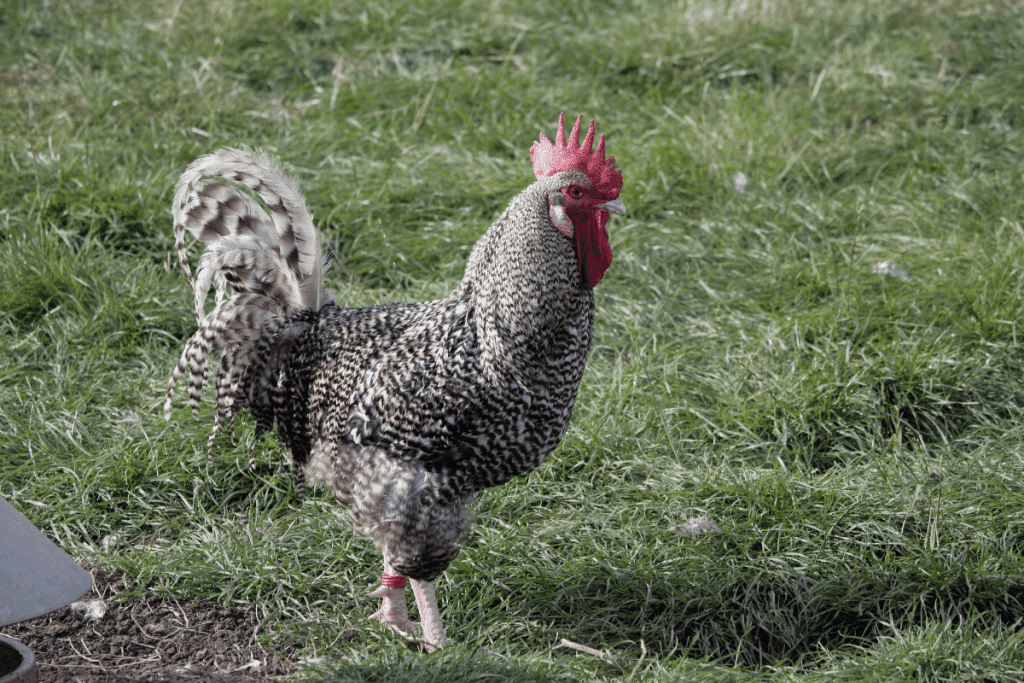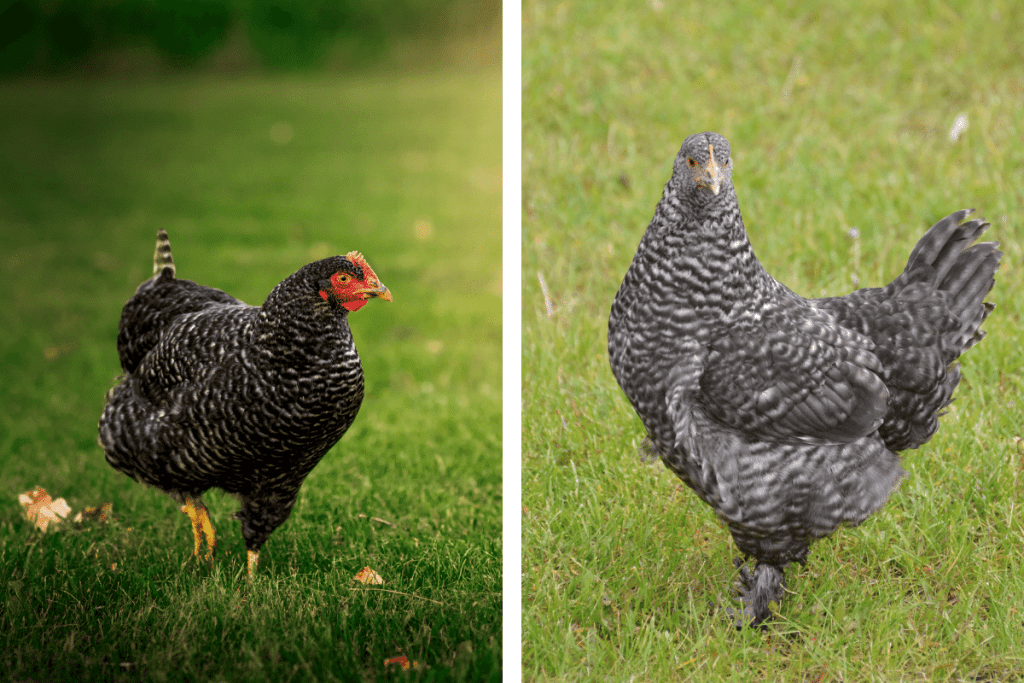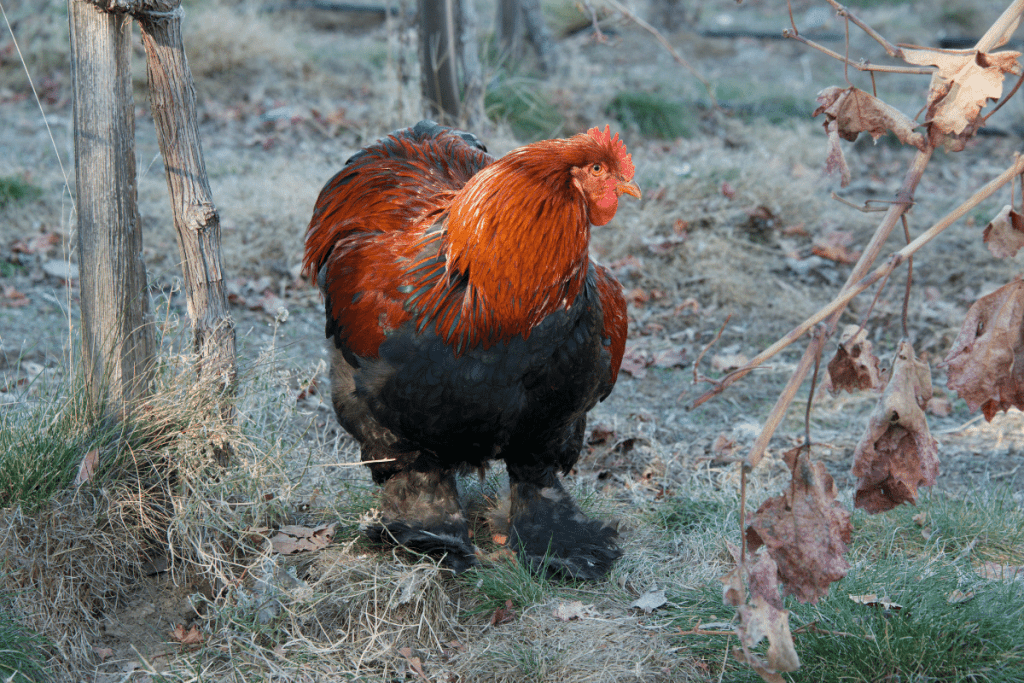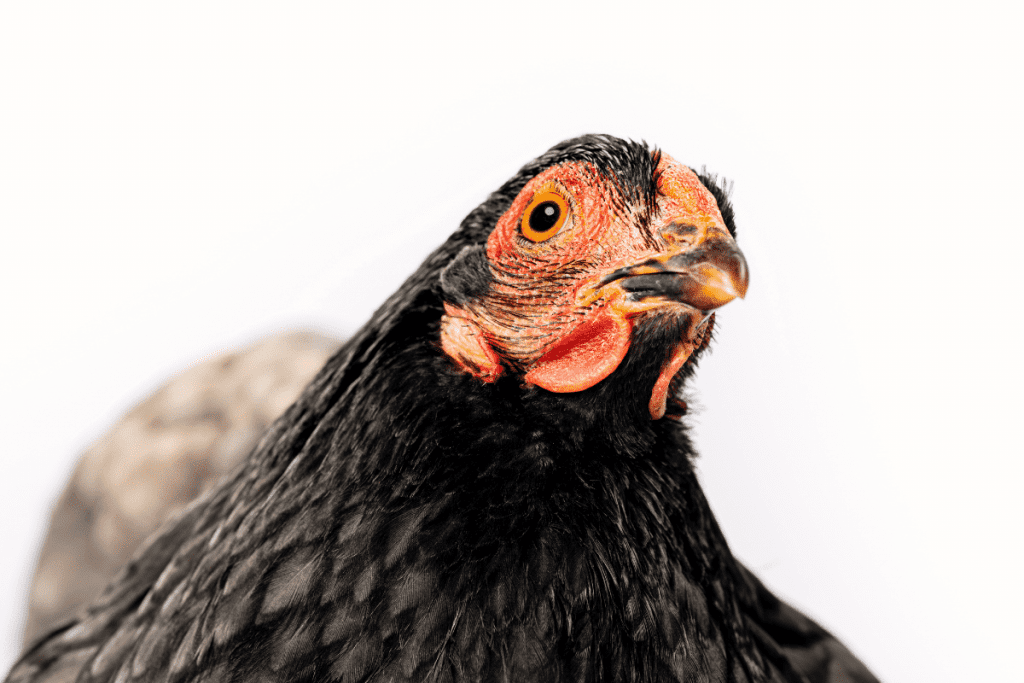In addition to meeting basic requirements such as egg production and hardiness for your environment, a diversity of chicken breeds can add some interesting color variations to your egg collection– including some lovely deep browns.
The main dark brown egg-producing chicken breeds include the following:
- Marans (French Cuckoo, French Black, French Black Copper, Cuckoo)
- Barnevelders
- Penedesencas (Crele, Partridge, Wheaten, Black)
- Welsummers
Whether you are looking for a show-quality bird or an all-around chicken to add to your backyard flock, you will certainly be able to find the chicken breed for your specific needs among these options.
This post will tell you everything you need to know about which breeds produce the darkest chicken eggs and their characteristics and overall profile.
Table of Contents
ToggleMarans

Marans are fabulous birds for those seeking a deep, chocolate brown egg color from their layers.
These beautiful birds originated from France during the 1920s and are somewhat rare in the United States.
Marans serve as dual-purpose birds for meat and eggs.
They come in various colors and are also popular as show birds.
When viewed from the side, Marans have a V-shaped body, and they have orange eyes with red combs, waddles, and earlobes.
They have high egg production, laying about 150-200 eggs per year.
Marans is a very hardy chicken breed.
These birds are heavy, cold-tolerant, and do well in confined areas. Hens average 7 pounds, and the roosters average 8.5 pounds.
There are several varieties and a diverse assortment of colors within this breed.
The following varieties of this French breed are ideal for dark brown eggs:
- French Cuckoo
- French Black
- French Black Copper
- Cuckoo
French Cuckoo

The French Cuckoo Marans is one of the most attractive Marans chickens.
It is particularly rare in the United States as a heritage chicken breed.
They have distinctive speckled feathers (also looks like jagged, irregular stripes) and feathered legs.
The eggs of the French Cuckoo are considered the darkest of the dark brown egg layers.
These eggs are darkest at the beginning of their laying season and sometimes get lighter as the season continues.
This subvariety of Marans grows more quickly than other Marans and is therefore suitable for both meat and their lovely, dark brown eggs.
French Cuckoo Marans are friendly and docile birds, and they enjoy being outdoors in a free-range setting, even in a cold environment.
These combined traits make the French Cuckoo a versatile variety for everyone, from commercial flock owners to backyard chicken owners to those looking for a show bird.
French Black
French Black Marans are distinguished from other Marans by their magnificent black feather color.
Like the other varieties, their importation into the United States is limited, so this elegant-looking variety is relatively hard to come by.
The hens have very soft and fluffy feathers, while the roosters have smoother feathers.
French Black Marans will lay up to 200 chocolate-colored eggs per year.
They sometimes have a few spots of white feathers early in life, but all feathers will be solidly black by about 6 months of age.
French Black Marans are social and friendly chickens, and they get along well with other members of a flock.
They are also hardy foragers who will thrive in various environments.
Want to see more black and white chicken breeds? Check out our list!
French Black Copper

French Black Copper Marans lay light red to deep chocolate-colored eggs.
The eggs sometimes have darker speckles as well. This variety lays about 150-200 eggs per year.
The French Black Copper chickens look similar to the French Black Marans with black feathers and green iridescence, but they also have striking, copper-colored accent feathers around the neck and back area.
French Black Copper Marans are active and gentle birds.
Like other Marans, they are extremely winter hardy.
They do not, however, lay eggs during the winter months.
French Black Copper hens will begin to lay eggs at about 8 months of age, and their eggs tend to be darker when the hen is younger.
The eggs will also be darker if the hen is laying fewer eggs, so the hue depends on the total volume of eggs you are getting.
Cuckoo
The Cuckoo Marans chicken is another attractive breed if you’re looking for brown egg-laying chickens.
Of all the Marans in the U.S., the Cuckoo Marans are one of the most popular varieties.
It was also one of the first Marans varieties exported from France.
Their feathers appear to have irregular white and dark gray jagged stripes throughout.
This barred feather pattern is what gives them the name “cuckoo.”
Many chickens called Cuckoo Marans are not feathered and have pinkish-white legs.
However, according to the American Poultry Association, only birds with feathered shanks meet the official breed requirements.
The Cuckoo Marans is not a particularly heat-tolerant chicken but a cold-hardy and active bird.
This variety of chicken is a good free-range forager and well suited to confinement.
Barnevelders

The Barnevelder chicken breed is famous for its medium to large, chocolate brown eggs.
However, before you rush out to buy them, know their eggs naturally come in various colors, ranging from cream-colored eggs to very dark brown eggs.
The darkest eggs require specific genetic breeding, making them hard to come by.
Barnevelders are named for the Barneveld region of Holland, where they were developed during the 19th century.
This breed of chicken was produced by crossing Dutch chickens with multiple Asian breeds, most likely Brahma, Cochin, and/or Croad Langshan chickens.
The Barnevelders were specifically bred for the color of their eggs and for laying during the winter months.
The hens lay approximately 150-200 medium to large eggs per year.
They start laying eggs at about 8-10 months (a bit later than the 6-month average for most dual-purpose birds).
Though they may not produce as many eggs as some other laying breeds, their winter-laying ability and rare egg color is worth it for many people seeking heritage breeds.
There are several varieties within the Barnevelders, but the most common variety is the double-laced Barnevelder.
The hens have striking, partridge-like feathers.
They are black with a green beetle sheen and a dark gold lacing pattern.
This double-laced variety is currently the only Barnevelder variety accepted by the American Poultry Association.
These lovely chickens are soft-feathered, with a single red comb, yellow legs, yellow skin, and reddish bay eyes.
In addition to their attractive appearance, Barnevelders have a great temperament.
They are friendly and calm birds making them a great choice for backyard chicken enthusiasts or people with children.
This, combined with their poor flying skills, makes them a great domestic breed for any flock, including those looking for good beginner chickens.
The Barnevelder chicken also tolerates a wide range of weather conditions and is considered a cold-tolerant chicken.
They are good at foraging when raised free-range and tolerate more confined urban conditions.
The only real downside to this breed is their susceptibility to Mareks disease.
This disease is not treatable but is easily prevented through vaccination.
Because of their large size, Barnevelders are dual-purpose birds raised as both excellent meat birds and layers.
However, they are not very fast-growing birds.
Meat birds are ready to be slaughtered after 6 months.
Like many brown egg layers, the Barnevelders are still a somewhat rare breed in the United States.
Penedesencas
The Penedesencas are a Spanish breed of chicken originally developed during the 20th century in Catalonia.
This Spanish chicken has beautiful plumage (color depends on the variety) and a lean body type.
One of their most distinctive features is their unusual “carnation comb.”
This is also sometimes referred to as a “king’s comb.”
It appears as a single comb in the front, but it branches into multiple combs toward the back, giving it a flower-like appearance.
Both males and females have a carnation comb, but on the roosters, they are upright, and on the hens, they tend to lay off to the side.
Although many people use a chicken’s earlobe to indicate their egg color, Penedesencas is an exception to this trick.
Although their earlobes are red with a white center, the hue of their eggs ranges from terracotta (reddish) to chocolate brown color.
The eggs will also occasionally have dark speckles on them.
Penedesencas are active and rarely broody.
They will produce approximately 140-160 eggs on average per year.
Their temperament is a bit nervous and flighty, and they are excellent foragers.
This makes them highly suitable for a free-range environment.
As with all chickens, they will be less skittish if handled regularly from a young age, but in general, this breed is definitely not a lap chicken.
I do not recommend it as a “family chicken” or for those who like to cuddle their chickens.
Because of their small stature, Penedesencas are not cold-hardy, but they do very well in hot climates.
Check out these other chicken breeds who do well in hot weather.
Within the breed, there are 4 different varieties:
- Crele
- Partridge
- Wheaten
- Black
The Crele, Partridge, and Wheaten varieties of Penedesencas were specifically developed for better egg production after the breed nearly went extinct during the 1980s.
Crele
This hen with a cuckoo-barred plumage features beautiful colors and stunning brown eggs.
They typically grow to be around 4.5-6 pounds.
One great advantage of the Crele Penedesencas is its autosexing characteristic.
At one day old, the males are gray, and the females are brown, allowing the owner to quickly sell them already sexed.
Partridge
These hens were bred specifically for optimal egg-laying.
They lay medium-large eggs in rich, dark chocolate brown eggs.
Even though the Partridge has white earlobes, it doesn’t lay white eggs (which is the general rule).
Wheaten
This variation of the Penedescencas is much like its parent except with wheat-colored feathers with a little black throughout.
Also of note are its light slate shank and toes compared to the main breed.
Like all variants, the Wheaten lays those dark brown eggs, so many people love to eat.
Black Penedesencas
The Black Penedesencas were this type’s original and were bred to be dual-purpose birds.
They are slightly larger than the other varieties, with an average mature weight of 5.5 – 6.5 pounds for cocks and 4.5 – 5 pounds for hens.
Welsummer

This Dutch bird originated from the eastern Netherlands and was first imported to the United States in 1928.
Although they are still not very prevalent in the U.S., their big claim to fame is the iconic Kellog’s brand mascot–a Welsummer rooster.
Welsummers are friendly and docile birds.
They are also not very good flyers and enjoy foraging in a backyard and free-range setting.
Due to their native habitat, Welsummers enjoy a cooler environment and are not particularly heat-tolerant.
If you experience some hotter weather where you live, make sure you have a shady, cool place where these birds can relax without being too stressed.
They are intelligent chickens, and although they are generally easygoing birds, they also tend to be quite vocal when they are stressed or in conflict.
Welsummers produce 160-250 eggs per year, and they do not lay during the winter months.
Their eggs are a rich, terra cotta brown in color, sometimes with dark speckles.
If you are looking for a broody, motherly breed of chicken, Welsummers are rarely broody and are not a good choice of bird for this purpose.
However, the Welsummer chicks may be auto-sexed as soon as they are hatched, which is a great breeding advantage.
The females have a darker head and more distinct color patterns, whereas the males have a lighter, fuzzier pattern.
Welsummers are generally considered a resilient and hardy breed.
These easygoing birds are a great choice as a dual-purpose breed, as long as you have plenty of space for them to forage and wander about.
Other Common Questions
What factors affect egg color?
Egg color is primarily affected by the chicken’s genetics.
However, there are many other factors leading to significant variation within breeds beyond this.
Some of the primary factors include the following:
Life stage
Eggs laid earlier in life will be darker and gradually become lighter over time.
More specifically, the tapered end of the egg will often have less pigment than the rounded end as the hen gets older.
This is a result of natural eggshell pigment intensity reduction.
Season
Eggs laid at the beginning of the laying season will be darker than those towards the end of the laying season.
Stress
Stress can cause chickens to lay lighter-colored eggs than they normally do.
As with humans, stress is caused by a wide range of things.
This includes high bird density, loud noises, aggressive or too much handling, exposure to new birds or other animals, extreme weather, etc.
How useful was this post?
Click on a star to rate it!
We are sorry that this post was not useful for you!
Let us improve this post!
Tell us how we can improve this post?
